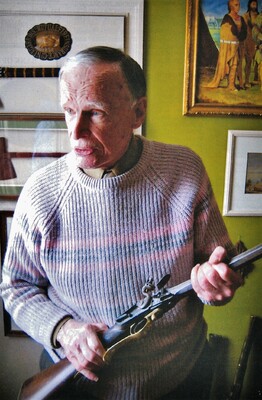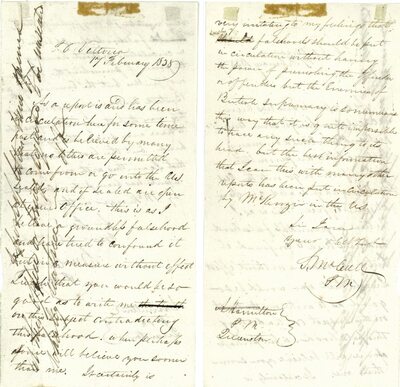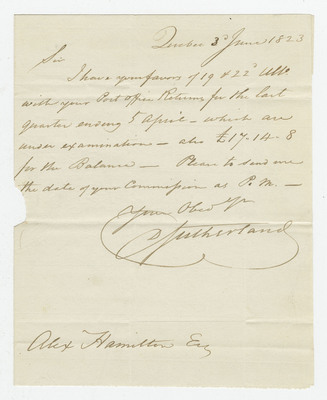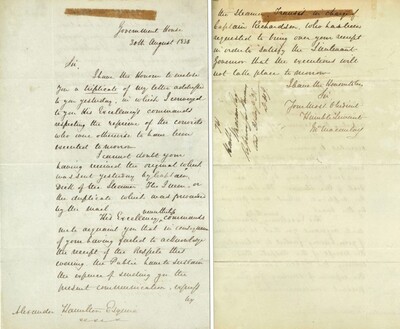-

Descendents of the Woodruff / Taylor / Band families. In front from left to right are: Martin Band, Julia (Taylor) MacDonald, and Chris Taylor. In the back are the extended family.
-

Robert "Bob" Band holding a musket
-

Photos in silver case of Percy and Robert Band, n.d.
-

This circular, dated at St. Catharines, July 12, 1823, and addressed to Alexander Hamilton, Esq., from W. Hamilton Merritt, is one of the earliest printed references to the construction of the Welland Canal. That same year, Merritt had organized local meetings to gain support of his plan to build a canal connecting Lake Ontario and Lake Erie. The circular reads 'the accompanying Report and Address to the Public, together with the Proceedings of the Meeting, will point out to you the object of this Circular…'. The report and address are not enclosed. Merritt asks for Hamilton’s assistance in 'promoting so necessary an undertaking…I have taken the liberty of appointing you an Agent for Queenston without your previous concurrence. If you decline acting, have the goodness to hand it to some respectable person of your acquaintance who will exert himself…'
-

A printed form showing Alexander Hamilton as Sheriff of Niagara District, taken from a blank form.
-

A watercolour of the Alexander Hamilton House, Queenston (Niagara-on-the-Lake, Ontario) by Owen Staples, 1913
-

The letter contains a copy of the resolutions passed by several gentlemen of Niagara for the purpose of adopting measures for providing relief to the distressed wives and families of the Greeks, whose commerce and agriculture have been destroyed in consequence of an arduous and protracted conflict. A list of subscribers is included, some in print but most handwritten. The letter is signed by Thomas Green and George Phillpotts, January 30, 1827.
-

The letter is an invitation to a meeting for the purpose of appointing persons to open books of subscription for receiving stock in the different county Towns in this province for the Welland Canal Company. The meeting is scheduled for Saturday the 31st at the Hotel of the widow Rogers in Niagara, January 24, 1824.
There is also a certificate for stock shares in the Welland Canal Company. The certificate is not completed, n.d.
-

Letter to A. Hamilton at Queenston from S. McCall, P.M, Vittoria. The letter concerns a report that it is believed that no letters are permitted to come from or go into the Old World, and if sealed, are opened at your office. The writer believes this is false, and asks that Hamilton write him back to confirm this. The writer believes that this report may have been put in circulation by McKenzie in the U.S., February 17, 1838. A reply by Hamilton is included. He addresses the issue of letters being opened at this office, but the remainder of the message is largely illegible, n.d. No postmark.
-

Circular (printed) to all Post Masters in both the Canadas from T.A. Stayner, D.P.M.G., General Post Office, Quebec. The letter concerns the political unrest in Canada in 1837. It is stated that while the Province of Lower Canada continues in a disturbed state, it is expected that any information likely to be of service to the Government will be transmitted to him, or to the nearest Civil and Military authorities in either Province, and to the Post Office Surveyors. Should it come to anyone’s attention that there is a Traitor in the Camp, this should be immediately communicated to both him and the Surveyors so that that individual may be properly dealt with. In cases of urgency requiring special reports to be sent by conveyances other than the regular Post, the expense incurred will be paid, November 25, 1837. No postmark.
-

Letter to Mr. Hamilton of Queenston from Mr. Scobie, General Agent, London. The letter refers to an understanding between the proprietors of the newspapers the New York Immigrant and the Old Countrymen, and the Postmaster at Lewiston, that the U.S postage on the Emigrant was to be charged against the Canada post office upon entry into the province at Queenston. It is also noted that there was an understanding that no such charge was to be made on the Albion, their U.S. postage having always been paid by the proprietor. The writer adds that several subscribers to the Albion have stated that they have been charged the U.S. postage on the paper. He refers Hamilton to the Postmaster at Lewiston on the subject, with whom Dr. Bartlett settles annually for the Albion postage, London, July 11, 1837. An entry by the post office at Lewiston is included below, which states that it is by mistake the postage is charged, if it ever is. It is noted that the Albion sometimes comes mixed with other papers, so it is possible they are charged by mistake, July 19, 1837. A reply by Hamilton is included after this, which was sent to the U.S. Postmaster [name illegible]. He writes that he has stated that he is not authorized to make the collection, but he would forward the letter for your information, n.d. Postmarked London 12 July (date handwritten).
-

Letter to Alex. Hamilton, Queenston, from Z. Hell, St. Johns. The letter concerns American postage due to Hamilton from the St. Johns post office. The writer tries to clarify a rumour that he is planning to take a case against Hamilton to the Commissioners of the Court of Request concerning U.S. postage charges, which involves a Mr. Davis, April 27, 1838. Postmarked Saint Johns, U.C., May 3 38 (date handwritten).
-

A broadsheet sworn and signed at Queenston by Malcolm Laing, J. P. and Alexander Hamilton, Post Master. The Post Office at [Queenston?] in account with the General Post Office at Quebec. The cash transmitted is 91.42 1/2 pounds. There is a watermark of an oval with a woman in a chariot holding a trident and a flower, August 11, 1835.
-

Circular (printed) to the principal Post Offices and those in immediate communication with the United States, from T.A. Stayner, D.P.M.G., General Post Office, Quebec. The circular concerns packet postage. The letter notes that a ship postage or tax of 12 ½ cents or 7 ½ d for a single letter will be added to letters and packets sent from this Country. It is stated that there is no other way of maintaining Post communication with the other side of the Atlantic (via New York) than by submitting to this regulation. This charge is in addition to the United States and British inland postage. The postage must be exacted on all letters sent to Europe via New York, December 26, 1838. No postmark.
-

Instructions to a Deputy Post Master in Canada Upon His Appointment. "Queenston" is written in as the place of employment. The booklet is loosely sewn together. Additional instructions are pasted after the third leaf and on the inside of the back wrapper. This copy is signed and annotated by T. A. Stayner who was the Deputy Postmaster General of British North America. The paper belonged to Alexander Hamilton "A. Hamilton Esq." is handwritten in the upper right corner.
-

Sketch of Niagara River between Queenston and Chippawa (coloured). Red arrows affixed to the map mark certain locations, including Lewiston; Queenston; the crossing over the Niagara River between Queenston and Lewiston; Portage Road; Ferry Miles (2 ½) over the River between Fort Schlosher and Chippawa Creek; and Chippawa. The map is engraved by J & C Walker, n.d.
-

Letter to Alexander Hamilton of Queenston from T.A. Stayner of Quebec. The letter concerns the extension of the mail route to Niagara. Mr. Cook (a contractor) has offered to extend his roads to Niagara in consideration of being allowed to part from that office in the morning, heading to Queenston by about 10, and then proceeding to York immediately. He states that he wishes the offer to go into operation with speed. He adds that it will be necessary for the Queenston mail to be ready to by 10 o’clock instead of 12. Since the American mail generally arrives in the evening, he points out there should be sufficient time to have the mail ready. He notes that by accepting this offer, five mails a week are deemed to Niagara instead of two as at present, January 4, 1831. Postmarked York UP-CAN (date illegible).
-

Letter to Alexander Hamilton of Queenston from D. Sutherland of Quebec. The letter addresses Hamilton’s concerns about the new tariff of distances and rates of Postage, and how they were calculated. Sutherland acknowledges that there are several errors, but that the distances were taken from the Surveyor General’s Office in Upper Canada, and the rates of postage are determined by an Act of the British Parliament, May 2, 1822. Postmarked Quebec MY 4 22.
-

Letter to Alexander Hamilton of Queenston from D. Sutherland of Quebec. The letter states that he received the post office returns for the last quarter ending April 5, with a balance of £17.14.8. He asks that he be sent the date of Hamilton’s commission as P.M., June 3, 1823. A reply from Hamilton is included on the reverse, which states that he has referred to his commission as postmaster of Queenston and found that it is dated September 9, 1820. The reply is dated June 16, 1823. Postmark is illegible.
-

Printed circular to Alex Hamilton of Queenston from D. Sutherland, General Post Office, Quebec. The letter concerns the practice of postmasters franking letters and packets for their friends, and a reminder that this is not allowed. It is stated that anyone who continues this practice will be dismissed. The only letters permitted to go free are those concerning matters between postmasters or the Department, January 4, 1826. No postmark.
-

A reprieve for convicts who were scheduled to be executed the following day.
-

A broadside which was printed at the Telegraph Office opposite the British Hotel by Webb, Printer. The notice was given that a fair or mart would be held at St. Catharines on Thursday, May 25th between 9 in the forenoon and sunset, pursuant to His Majesty’s letters patent of July 8, 1836. Alexander Hamilton is listed as the steward. The broadside is dated at Niagara, April 15, 1836. There is an annotation on the opposite side of the broadside regarding the date of the fair, which has bled through.
-

Letters patent to establish a fair or market in St. Catharines which give Alexander Hamilton the authority as the Sheriff to collect the tolls. The Royal Coat of Arms is in the upper left hand corner of the first page and the document is signed by Sir Francis Bond Head, Lieutenant Governor of Upper Canada; Robert S. Jameson, attorney general and D. Cameron, secretary.
-

Return of Prisoners Confined in the Niagara Gaol, Alexander Hamilton, Esquire, Sheriff [October 1 is crossed out and replaced with January], 1834. Most prisoners were committed on a writ of Capias [a writ issued by a court to bring the defendant, having failed to appear, to answer a civil action against him.]. There is a watermark: “WEBSTER 1831”, 1833-1834.
-

Two List of Property Taken Under Execution blanks.
























